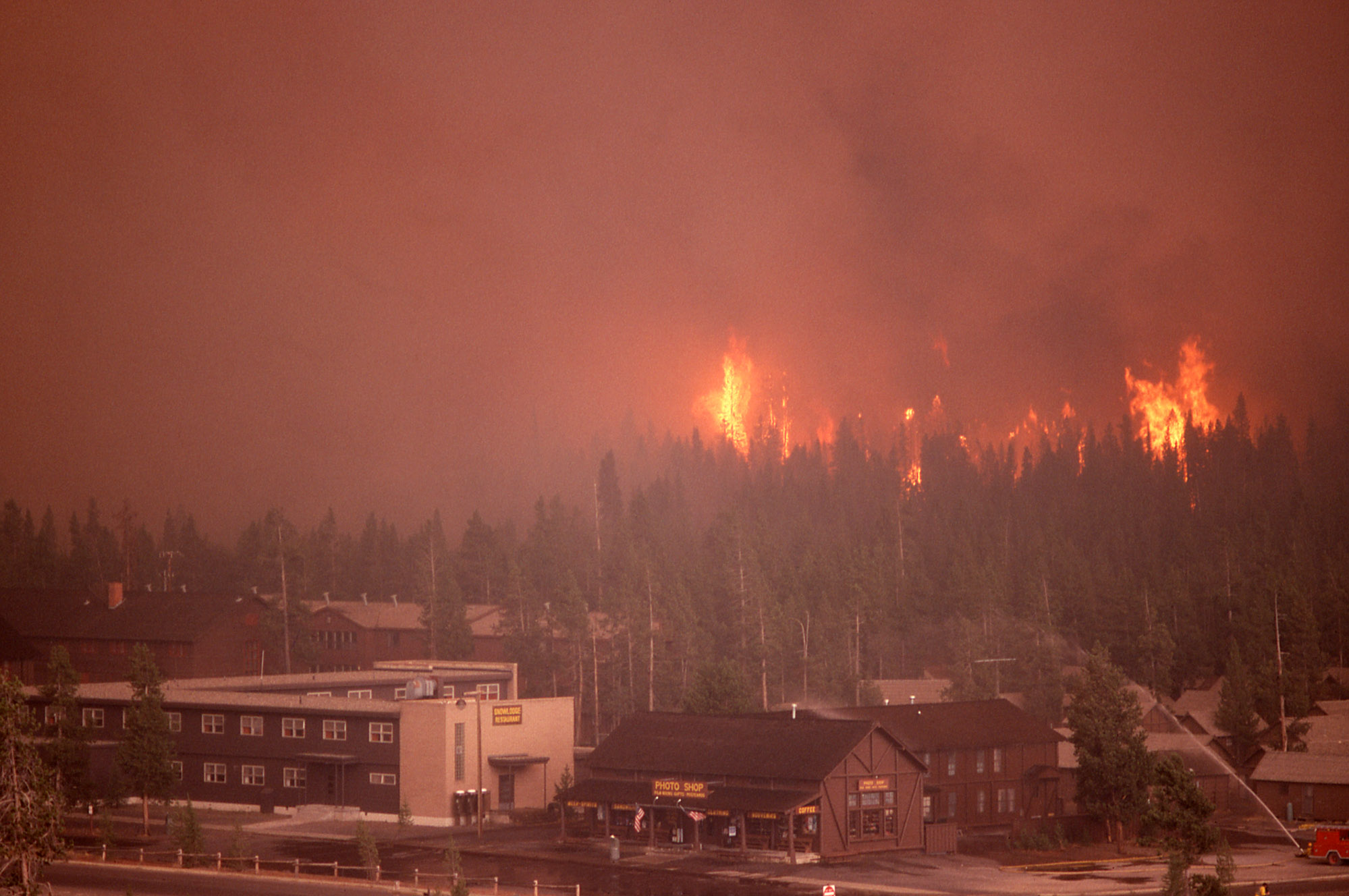Antwort What caused the 1988 Yellowstone fire? Weitere Antworten – Why did the Yellowstone fires of 1988 start

The largest fire in the park was the North Fork Fire, both in terms of damage to structures and of area burned. The fire started on July 22, when a man cutting timber dropped his cigarette in Caribou-Targhee National Forest just outside the park's western border.Relatively few animals (only about 300 large mammals) died because of the 1988 fires. Of Yellowstone's seven native ungulate species, only the moose population has declined since 1988. All ungulate species experienced increased mortality the winter after the fires, but elk, bison, and deer populations rebounded.1.4 million acres
The Fires of 1988 that burned 1.4 million acres in the Greater Yellowstone Ecosystem—including 793,880 acres of the national park—were the result of a perfect storm of environmental and human factors.

How did the Yellowstone fire affect the atmosphere : The forest fires could cause acid rain. As with industrial pollution, CO2 from the fire would combine with the moisture in the atmosphere to form carbonic acid, or H2CO3. Intense fires create their own upward air movement.
What are some interesting facts about the Yellowstone fire
Most Yellowstone Fire Starts Don't Spread Beyond .
Overall, according to the NPS, roughly 75% of Yellowstone fire starts never grow beyond . 25 acres in size. In addition, 92% of Yellowstone wildfires never burn more than 100 acres. So, on the whole, fire isn't that big a worry for the park or its visitors.
When was the last big Yellowstone fire : 1988
1988 Fires – Yellowstone National Park (U.S. National Park Service)
Top 12 Largest Wildfires in History
- 2003 Siberian Taiga Fires (Russia) – 55 Million Acres.
- 1919/2020 Australian Bushfires (Australia) – 42 Million Acres.
- 2014 Northwest Territories Fires (Canada) – 8.5 Million Acres.
- 2004 Alaska Fire Season (US) – 6.6 Million Acres.
- 1939 Black Friday Bushfire (Australia) – 5 Million Acres.

There are no active large fires at this time.
How many people were involved in the Yellowstone fire
25,000 firefighters
More than 25,000 firefighters—as many as 9,000 at one time—attacked Yellowstone fires in 1988, at a total cost of about $120 million. Thankfully, the fires killed no park visitors and no nearby residents.The 1988 fires probably will alter runoff and increase erosion in many locations on the Yellowstone landscape. Within the context of wilderness, such changes are expected and in some cases even desirable.Despite considerable manpower—more than 25,000 firefighters battled the blaze with as many as 9,000 fighting it at one time—the fires didn't subside until Sept. 11, 1988, when the first snows helped to dampen the flames. Smoldering spots continued to burn until November.

In all, 1.2 million acres burned in the greater Yellowstone area, including 793,000 acres of the park's 2,221,800 total.
What was the hottest fire ever : Highest temperature
Dicyanoacetylene, a compound of carbon and nitrogen with chemical formula C4N2 burns in oxygen with a bright blue-white flame at a temperature of 5,260 K (4,990 °C; 9,010 °F), and at up to 6,000 K (5,730 °C; 10,340 °F) in ozone.
What is the oldest fire still burning : Burning Mountain
A coal seam-fueled eternal flame in Australia known as "Burning Mountain" is claimed to be the world's longest burning fire, at 6,000 years old. A coal mine fire in Centralia, Pennsylvania, has been burning beneath the borough since 1947.
What are some interesting facts about the Yellowstone fires
Most Yellowstone Fire Starts Don't Spread Beyond .
Overall, according to the NPS, roughly 75% of Yellowstone fire starts never grow beyond . 25 acres in size. In addition, 92% of Yellowstone wildfires never burn more than 100 acres. So, on the whole, fire isn't that big a worry for the park or its visitors.

June 14, 1988Yellowstone fires of 1988 / Start dateWhat is the hottest flame color Hotter flames have predominantly shorter wavelengths. So they progress through red, orange, yellow, blue, violet, and ultraviolet.
Does Purple fire exist : Violet flames are actually the hottest type of flames discovered, not indigo or blue. That may be difficult to understand but violet flames are the hardest color to see on the color spectrum. Meaning they are the hottest flames can be whilst still being visible.

![csm_2405-bauerfeind-produktkategoriesseiten-bandagen-ellenbogenbandage-2560x1400_88-1_f91f66009c[1]](https://www.nakajimamegumi.com/wp-content/uploads/2024/06/csm_2405-bauerfeind-produktkategoriesseiten-bandagen-ellenbogenbandage-2560x1400_88-1_f91f66009c1-1024x521-65x65.jpg)
![Ischiasschmerzen[1]](https://www.nakajimamegumi.com/wp-content/uploads/2024/06/Ischiasschmerzen1-1024x640-65x65.jpg)
![csm_blogbeitrag_autoimmunerkrankung_d307ac8b72[1]](https://www.nakajimamegumi.com/wp-content/uploads/2024/06/csm_blogbeitrag_autoimmunerkrankung_d307ac8b721-1024x576-65x65.jpeg)